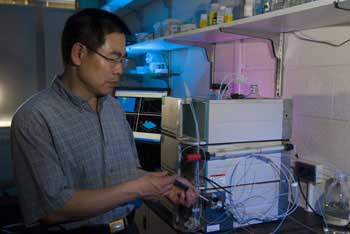Researchers have determined structure of important neurotransmitter regulator

Researchers from Virginia Tech and the Brookhaven National Laboratory have solved the structure of an enzyme that is critical in the regulation of the neurotransmitter system in the human brain.
The enzyme is human kynurenine aminotransferase II (KAT II), which regulates the activity of the neurotransmitter system that is activated by glutamate, the most common neurotransmitter in the brain.
Qian Han, a research scientists in biochemistry at Virginia Tech; Howard Robinson, a biologist at Brookhaven; and Jianyong Li, associate professor of biochemistry at Virginia Tech, report their findings in the article, “Crystal structure of human kynurenine aminotransferase II,” in the Feb. 8 issue of the Journal of Biological Chemistry.
Li, who is corresponding author, explained that learning and memory depend upon glutamate; however, over-stimulation will lead to neuron death and is one cause of neurodegenerative diseases such as Parkinson’s and Alzheimer’s.
“The product of KAT II is kynurenic acid (KA) that is a noncompeting binder of the glutamate receptors. Its binding to the glutamate receptors reduces stimulation. So [KA] has a regulatory effect,” Li said. “It is considered protective – although too much is also a problem,” he said.
Before scientists can target KAT II as a treatment, they have to know how it works. Part of the challenge was solved when the DNA sequence of KAT II was determined, but knowing the code is not enough. How proteins pass their critical messages also depends upon their shape. Imagine proteins as curls of ribbons with each unique fold as important to the messages they convey as the sequences of letters in their genetic code.
Han, Robinson, and Li succeeded in determining both the unbound protein and its complex three-dimensional structures of KAT II. The structure in complex with kynurenine reveals the almost ephemeral linkages of the KAT II enzyme with its substrate.
“Now we know what it looks like, we can determine how it works and do research into how to manipulate the protein,” Li said. “We have provided a molecular basis for biochemical regulation of this critical regulator.”
The article reports on Han’s research to crystallize KAT II in combination with a substrate. Robinson used a synchrotron to create X-ray diffraction patterns to reveal atomic and molecular associations within the crystal, which allowed Han and Li to do phase determination and an iterative process of model building and refinement and eventually describe the structure.
Learn more about Jianyong Li’s group.
Access an article abstract. Send address correspondence to: Jianyong Li, Department of Biochemistry, Virginia Tech, Blacksburg, Va., 24061, (540) 231-1182; E-mail: lij@vt.edu. Media may also contact ASBMB science writer Nick Zagorski at (302) 634-7366 or nzagorski@asbmb.org.
PHOTO ATTACHED: Biochemistry Associate Professor Jianyong Li applies a protein sample for the purification of a human aminotransferase II that will be used for crystallization and structural characterization.



